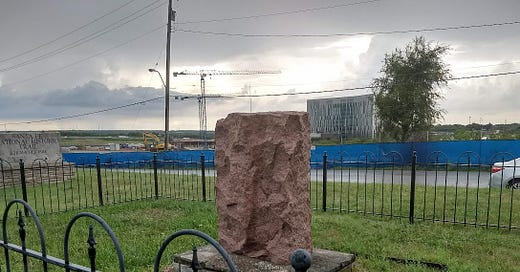West With the Wagons (3) Slow Rainy Sticky Going ☔
On the Way Out of Missouri, We Meet Migrants Who're Not Who We Expected. And Why Are We All Going South?
How Long Is This Post? About 6,500 words, or 30 minutes
SUPER IMPORTANT: Click on the headline above to read this post on the NBH site, or you likely won't see text or photos properly.
Dear Nonnie Friend,
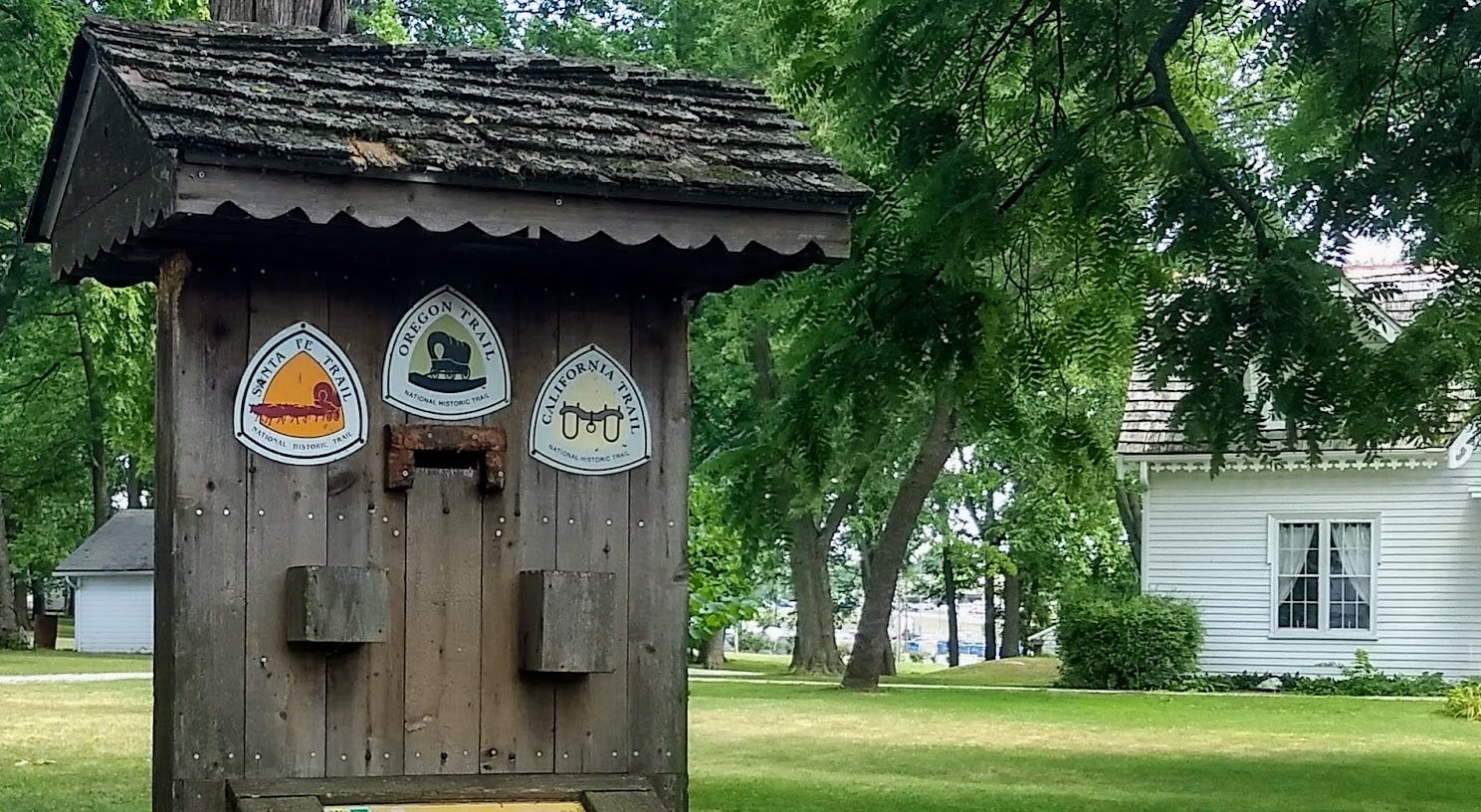
Continued from
THE JOURNEY SO FAR . . .
Hoosen (long-suffering spouse) and I flew in from Atlanta to Kansas City, and stocked up for our Westward journey in Independence, Missouri in 2018 (i.e. filled the gas tank, ate ice cream). We soon waved goodbye, perhaps forever, to the little town (now city suburb) from which thousands once set off West with covered wagons.
Our brief one-time stop in Independence wasn't much like the experience of 19th century commercial truckers, er, I mean, teamsters. They knew the city well. They regularly walked the commercial Santa Fe Trail (think freeway), shepherding the animals that pulled their big heavy freight wagons full of trade goods (think trucks) back and forth between Independence and Santa Fe, New Mexico.
We had a little more in common with most mid-19th century westward migrants headed to settle in Oregon and California.
The migrants were almost all strangers to Independence, who stopped in town only to prepare for their long and uncertain trip. Just like us.
If they hadn't come by land with wagons, or brought flatpack wagons from home, stowed in the holds of the steamboats that carried them west, then they plunked down big cash to buy wagons in Independence, along with mules or (more often) the cheaper oxen to pull them.
We flew in and rented a gerbil-powered car. See? Not so different!
1849 people visited Independence grocery stories, and bought hundreds of pounds of preserved dried foods for the journey.
Hoosen popped into a drug store, and bought a shopping bag full of mass-produced snacks, full of preservatives. The same! Sort of!
Duly prepared, 1849 migrants put up tents, camped in the fields around the city, found traveling companions if they didn’t have them already, and waited for the right time for chains of wagons to take off on their long journeys. They got rained on.
We checked into a modest but comfortable chain hotel. and spent a couple of nights. It rained, but whatever, we were inside. Okay, so maybe we had the edge there.
In the 1840s, the right time for migrants to leave for California was spring, when enough grass had popped up on the prairies to keep their wagon-pulling oxen or mules, horses (if any) and dairy cows (ditto) fed on the journey.
Timing was crucial. They knew they had to get across the West before deep snows fell in the Sierra Nevada mountains, that massive wall of rock that stood between them and California, gold, and safety.
We had to get back before Hoosen’s leave expired, but that’s not in the same league of anxiety, is it? Best I can explain what this pressure must have felt like in 1849 is to ask you to imagine that all the gas stations in the plains and deserts of the West closed for the winter season, and that, once they reopened in spring, you only had 48 hours to drive from the Midwest to the Pacific, or else something terrible would happen to you. And you would have to do that with little wiggle room for loo breaks, accidents, traffic, or flat tires. Yeah, anxiety.
Leaving Independence also means Hoosen and I were now heading into the open plains at last, right?
Um, no. Not quite. Like I said last time, in 1849, Kansas City didn't yet exist: It was settled the following year. But Hoosen and I were traveling in 2018, and in recent decades, Kansas City has expanded like The Blob (1958)
The Blob? Steve McQueen “and a cast of exciting young people” (an actual quote from the trailer) star in classic 1950s horror in glorious Technicolor, in which a giant red jelly eats the citizens of a small US town, just like that other red menace of the time, Communism. Highly recommended.
Blob-like Kansas City has since swallowed up farmland and neighboring towns, including Independence, and, along the way, it has obliterated many remaining traces of the Santa Fe/California/Oregon Trail. Nom nom nom.
So if you thought Hoosen and I would immediately hit the open trail today, I hope you’re not too disappointed.
But I do have good news! Our route skirted the suburban edges of Kansas City, all the way to the junction where Santa Fe freight wagon traffic separated from the wagons, riders, and walkers bound for the Pacific Northwest.
So Hoosen and I followed the wagon traffic for Santa Fe, Oregon, and California, and everyone followed the Santa Fe trail to get out of Missouri. That meant everyone, no matter their final destination, first headed south.
South, Laing? We’re going south now? I’m looking at a map, and I still don’t get it.
Yeah, I was confused at first, too. But stick with me here.
Oregon and Northern California are in the US Northwest, right?
Right ….
And Santa Fe is in the US Southwest, yes?
Uh huh . . . .
So the Santa Fe trail was the main road, the only freeway, if you like, leaving Independence. California and Oregon migrants, even though they weren’t going to Santa Fe, followed that freeway all the way to the frontier, the western border of Missouri. And that route took them south before it turned off for the West.
That's weird. Why did the California and Oregon traffic have to follow the Santa Fe road at all ? It's not like a trail was an actual road. You said so yourself. It was all over the place. Why couldn’t people going to Oregon and California just point the wagons west and go any way they wanted?
Because good luck getting a wagon, or even a horse, through uncleared long grass prairie and farmers’ planted fields, and across rivers at random points! Hard though it was to follow a trail, which was like a crazy spaghetti of rough dirt, it was the only practical option. That’s why everyone traveling through Missouri from Independence followed the Santa Fe trail as far as the exit where the Oregon and California traffic turned onto the Oregon trail to head northwest.
So let’s get on with the journey, and see what (and who) Hoosen and I found along the way.
No Hurry, Can’t Worry
Even if you’re raring to go, nobody following the Westward trails properly gets anywhere fast after leaving Independence, whether we're talking the migrants of 1849, or Annette and Hoosen in 2018.
Even with a perfectly functioning rental car operated by gerbils in optimum condition, Hoosen and I were slowed down by our need to stop and explore as many trail-related places as we could. I wanted to see every possible trace of that 1849 journey, to try to make sense of what we were seeing.
In 1849, even if all went smoothly, and the weather was nice, migrants' oxen-pulled wagons travelled at a leisurely three miles an hour. The animals (and the people) also needed frequent breaks for rest and refreshments.
Plus, migrants sometimes forgot things, or discovered early on the journey that something needed to be fixed, like a broken wagon wheel. That would mean retracing their steps, even all the way back to Independence if necessary. The blacksmith was the car mechanic of 1849, so you wanted to use his services while you could. After all, once you left Missouri, you were in Indian territory, and on your own, right?
A major reason your early journey was probably slow: This was spring, and it rained. A lot. Rain meant the dirt trail churned into thick, sticky mud under wheels, hooves, and feet, making travel difficult, or impossible. In 1846, future historian Francis Parkman discovered the problem before he even made it to Independence, shortly after disembarking his steamboat on the Missouri River:
Westport was scarcely out of sight, when we encountered a deep muddy gully, of a species that afterward became but too familiar to us. And here for the space of an hour or more, the cart stuck fast.
Any technical issue might add a day, or much more, to your trip west.
Let’s meet some more migrants. Introducing Hugh Morgan Price. Along with his two brothers, Calvin and Franklin, and friend Joshua Donaldson, Hugh left the tiny town of Millersburg, Ohio, for the California Gold Rush on March 29, 1849. The four guys headed for the city of Cincinnati, where they planned to board a steamboat to take them west on the Ohio River, on the first leg of their journey.
If you like, and I do recommend, look up Millersburg on Google Maps, and then you can get a better idea of the boys’ route.
I don’t know how Hugh and his three companions got to Cincinnati (horseback? foot? stage coach?). Starting three years earlier, in 1846, an Englishman (UK he was from Staffordshire) started working on a railway through Ohio. But the new railway hadn’t opened yet.
However, Hugh and the lads somehow made their way from Millersburg to Cincinnati. There, they bought four or five mules and a wagon (which I assume was flatpacked to fit into the steamboat's hold) before they boarded a riverboat for Independence.
The steamboat took them on the Ohio River to St. Louis. From there, they transferred to another boat to carry them West on the Missouri River, toward Independence. Don't imagine a nice, peaceful voyage: Trips along the shallow Missouri River typically ended up bumpy, snagged by obstacles along the way, sometimes running aground for hours, and their journey was no exception.
The guys arrived at the landing on the river at four in the afternoon, on April 7, and found it, in Hugh’s words, “Rainy. Disagreeable and muddy. Hard beginning for California boys.” That night, Hugh slept by the river on the bed of an abandoned old wagon. They started their trek to Independence the following morning.
All this travel took a while. Even after arriving in Independence, Hugh, his brothers and Josh Donaldson, didn’t leave town until almost a month after they had set out from home in Ohio.
That's because it was raining in Missouri. Pouring down. Meanwhile, the lads did what they could, and stocked up for their land journey.
“In laying in provisions,” Hugh Price wrote from Independence, “we determined to lay in nothing but the real substantials of life. Our provisions consisted of 600 lbs. of flour, 440 lbs. bacon, 227 lbs. crackers, 25 lbs. rice, salt for selves and mules.” They also bought 18 lb coffee beans (which would last me and Hoosen about five months), 1 lb sassafras tea [UK Not tea if you ask me] and a 20 lb sack of sugar. [UK If you want all this weight in grammes, you’ll have to figure it out]
“How would the Honda cope with about 1,500 pounds of stuff?” I asked Hoosen.
“Not very well,” he said. “It would manage, but that's hard on a car.” Hoosen wasn’t sure, though, how well a little covered wagon would manage, maybe better. Still though. They weren’t traveling light.
Not only was that a lot of weight to carry, but think about those dull dried foods as a diet, for months. Ugh. Nothing fresh. Then I remember that when Hoosen went to fetch our snacks, he came back with salty pistachios and almonds, and a bag of fruit-flavored Lifesavers.
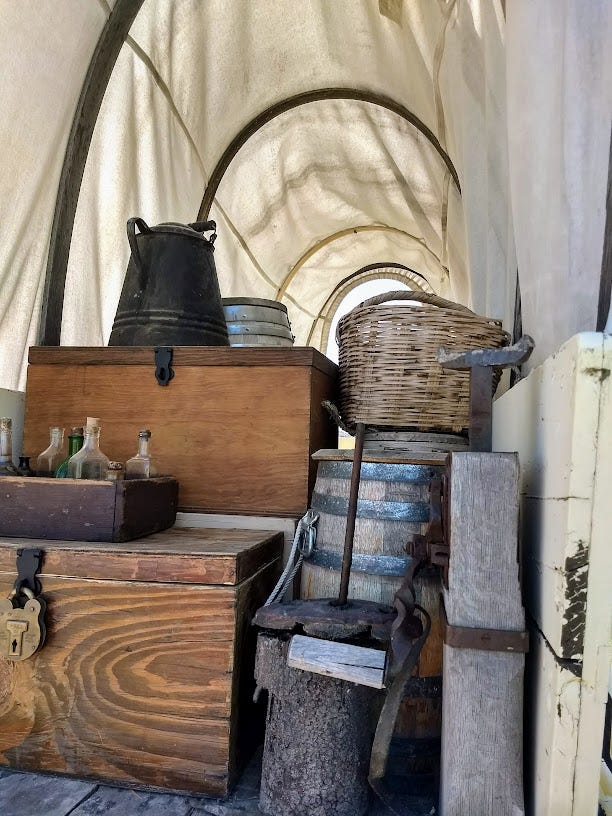
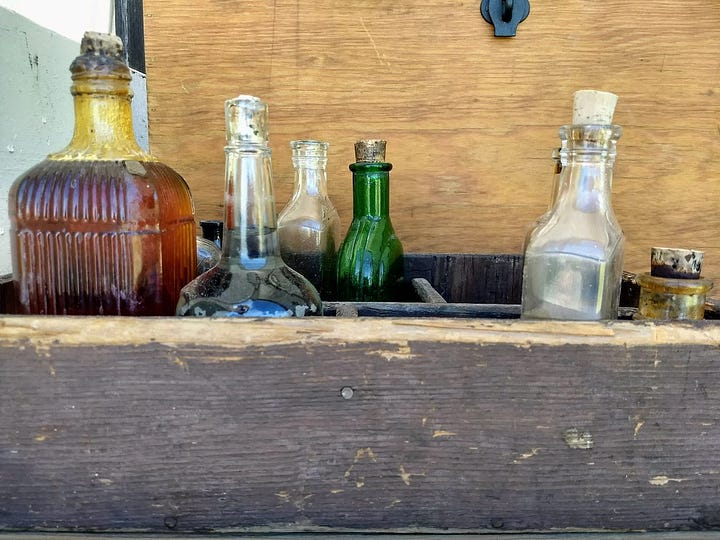
Hugh and the guys finally left Independence April 20, and the weather continued to suck. It bucketed down. So on this first day, heading south on the Santa Fe trail, they only managed a pitiful two miles.
Still, two miles was far enough for the guys to discover that their five mules weren’t enough for their needs. They bought a pony from an Indian man they met on the trail. I have no idea how this helped, because Hugh doesn’t say: Did pony and mules together pull the wagon? I can only guess.
The landscape south of Independence, Hugh writes, was “beautifully interspersed with prairie and timber”. Ah, not so much in 2018. More like houses, offices, and strip malls, interspersed with lawns and a few trees.
In the rain, it took Hugh and the lads a week of travel to get to their next campground, at “Mr. Rice's [house]”. This was just eight miles from Independence.
To my astonishment, “Mr. Rice’s House” still exists. And while it took Hugh and his companions seven days to travel there on the Santa Fe trail from Independence, the same journey by freeway took Hoosen and me all of about twenty minutes, even in Kansas City traffic. It’s about 11 miles. 11 miles in seven days? Not great.
Welcome, Campers! Camping at the Rice House
Important: Click on these photos to enlarge and expand them.

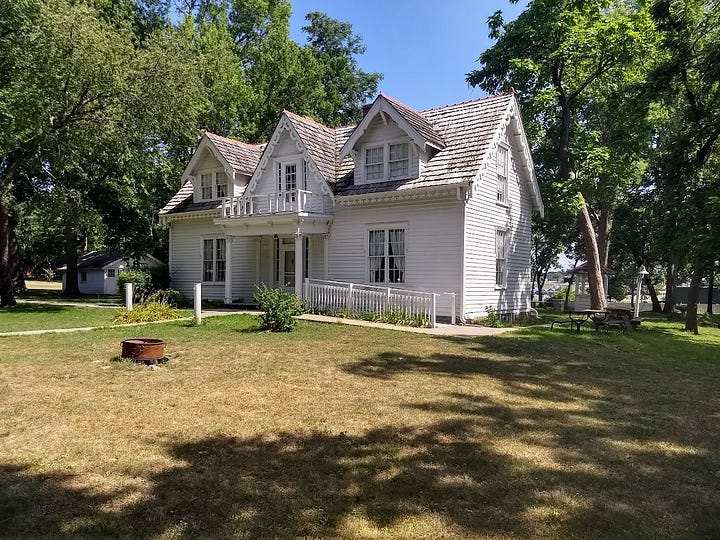
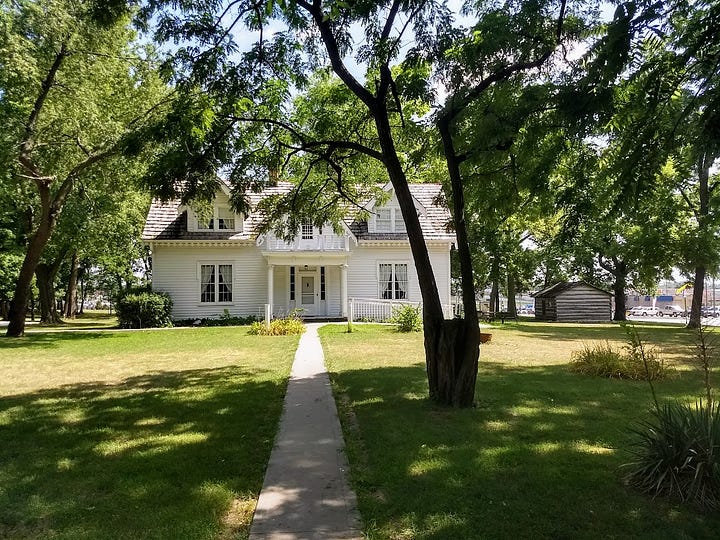
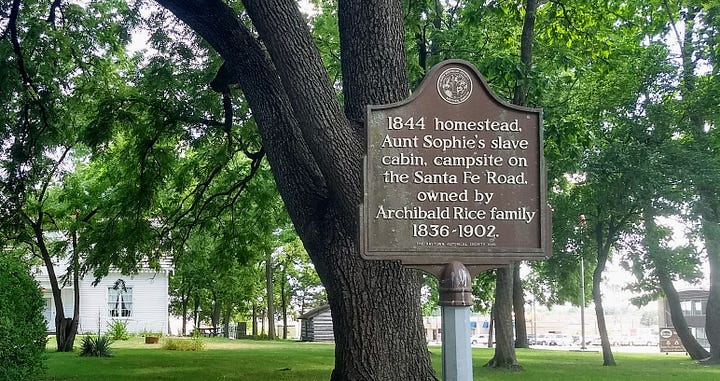
Many wagon people traveling from Independence on the Santa Fe/Oregon/California trail in 1849 stopped at the Rices’ place. It was an easy on/off detour: Turn right from the trail, and park your wagon in Archibald and Sally Wright’s spacious front yard. Think of it as an AirB&B campground.
So are you now imagining the front lawn in the photos above full of white people with wagons?
Don’t. Oh, of course, there were plenty of white people, that was America in 1849. But there’s a very good chance that a few of the people with the wagons were black, Mexican, or American Indian, among them migrants as well as teamsters, and including California goldseekers.
Up to 3% of the people who crossed the Plains were black. One example to blow your mind: A huge multiracial company of 130 Cherokee, white, and black goldseekers who set off from Arkansas with forty wagons in April, 1849, including ten free African Americans and five slaves. They didn’t stop here at the Rice House (look at a map of where Arkansas is, and you’ll see why), but others did.
Oh, and the Rice place isn’t just a campground in someone’s front yard. It’s also a bustling farm, and most of the men, women, and children doing the farm work (shepherding animals, carting hay, fetching water, or whatever you care to imagine, likely without paying much attention to the wagons and the strangers with them) are black. Here’s why:
Archibald and Sally Rice had settled here in 1836, built a log cabin, and begun farming with slave labor. The Rices built a larger house eight years later, and by 1849, they owned 21 people, including four children. I know, this doesn't sound all “nice" and covered-wagon romantic, but facts are facts, plus doesn’t the scene in your imagination seem not only more crowded now, but just make more sense?
I have no idea why the Rices opened a campground in the 1840s to people like Hugh Price, but the obvious answer is likely the correct one: The Rice Farm was directly on the Santa Fe trail, and their front yard was a nice, big open space. So a campground easily presented itself as a nice little side hustle that brought in cash.
The Rices’ house has been remodeled and renovated over the years, but however much it might have changed since 1849, notice that it’s still small compared to how we imagine prosperous slaveowners’ houses to be. It’s not exactly Tara from Gone With the Wind.
That’s because the big money in slavery, the income that allowed the building of grand mansions, was on the Atlantic Coast. The coastal southeast had good weather and fertile soils, allowing slaveowners to concentrate on a single profitable crop, which was, by this time, cotton. Being close to the coast gave slaveowners easy access to big Atlantic seaboard city and transatlantic markets, especially Britain.
The Rices, stuck out in flyover country Missouri, farmed corn, sheep, and cattle, among other products, using the forced labor of the people they owned. They obviously did very well. but you didn’t get super-rich from this kind of diverse agriculture in the boonies [UK remote rural areas].
The Rice-Tremonti Farm and House, as it’s now called, no longer operates as a farm or campground, and it's no longer a private home. Hoosen and I couldn't tie up the Honda in the orchard, so we parked in paved designated spaces, for, I suppose, a limited time, although we didn’t stay long anyway. The house was normally open for tours, but it was closed for a private function that day.
In other words, we didn’t linger, unlike Hugh Price and his companions in 1849, who hung out here for an entire week. Hugh didn’t have a lot to say about this period, except for one ominous note: Another Ohio man camping alongside them at the Rice farm died from cholera.
On May 5th, 1849, Hugh and the lads finally left the Rice Farm and continued their slow progress, traveling only four miles before camping again.
About six months later, Archibald Rice died (and before you ask, and despite rumors, probably not from cholera, plus he was in his late sixties). His wife Sally outlived him by just three years.
On July 13, 2018, after nearly 170 years, Hoosen and I finally followed Hugh and the boys out of the Rices’ front yard, and turned back onto the paved modern road that long ago replaced the Santa Fe trail. Just like the 1849 migrants, we couldn’t stay long, even if there was more to keep us here. As we left, we passed “Aunt Sophie’s Cabin”. Hang on. Let’s talk about that.

